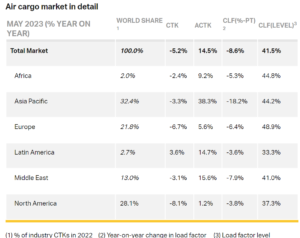
The International Air Transport Association (IATA) released data for May 2023 global air cargo markets showing weak market conditions. Global demand, measured in cargo tonne-kilometers (CTKs), fell 5.2% compared to May 2022 (-6.0% for international operations). Capacity, as measured by available cargo tonne-kilometers (ACTKs), rose 14.5% compared to May 2022, primarily driven by belly capacity which increases as demand in the passenger business recovers. Capacity is now 5.9% above May 2019 (pre-pandemic) levels.
Key factors influencing demand include
- The global manufacturing Purchasing Managers Index (PMI) indicates an annual contraction of 1.4% in new export orders and a decrease of 5.2% year-on-year in production PMI. This suggests a cooling in global manufacturing demand.
- Global goods trade decreased by 0.8% in April, due to macroeconomic challenges and supply chain constraints. Trading conditions appeared to favor maritime cargo as demand for container shipping contracted by 0.2% while air cargo demand weakened by 6.3% year-on-year.
- The global supplier delivery time PMI increased to 54.5 in May, up from its low of 35 in October 2021, indicating shorter delivery times and some relief for supply chains. However, this is also a sign of weaker global goods trade demand.
“Trading conditions for air cargo continue to be challenging with a 5.2% fall in demand and several economic indicators pointing towards weakness. The second half of the year, however, should bring some improvements. As inflation moderates in many markets, it is widely expected that central bank rate hikes will taper. This should help stimulate economic activity with a positive impact on demand for air cargo,” said Willie Walsh, IATA’s Director General.





